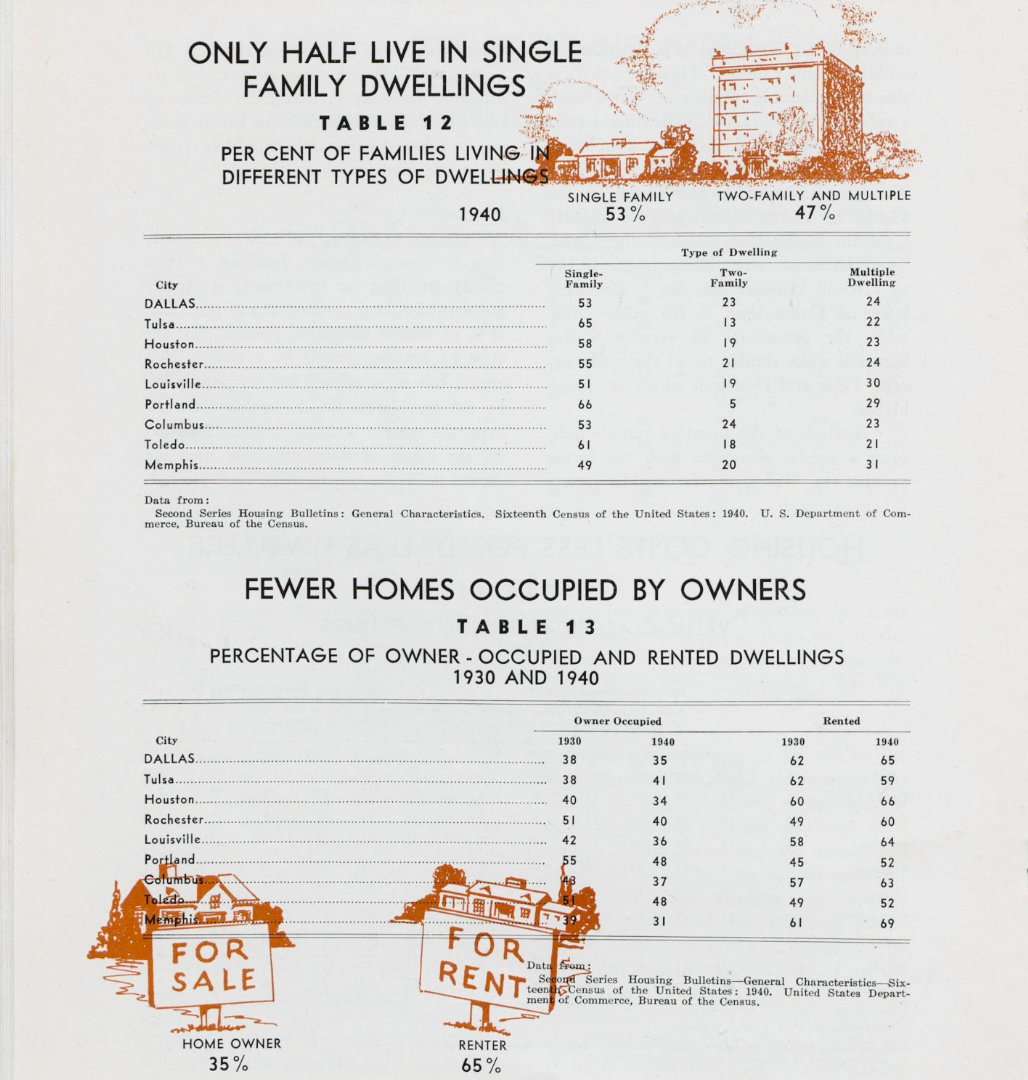Policy
Dallas Rewrites Its Zoning Legacy to Fix Housing Shortage
After decades of single-family dominance, Dallas is embracing density again. A landmark ordinance revives small-scale housing once zoned out of existence — and signals a turning point for Texas growth policy.

Dallas once had duplexes and other multifamily housing interspersed with single-family homes.
That began to erode substantially in 1945 after the city adopted a comprehensive plan created by a national firm with a long history of separating residential zoning into distinct districts, focusing primarily on single-family housing.
Now, the city is reaching into its past for a solution to current conditions, joining a nationwide movement to restore housing options that were zoned out of existence.
Facing a shortage of diverse housing options, Dallas set a course in April to encourage "missing middle" housing with a landmark ordinance that allows up to eight units under residential code. It cleared the path for a new wave of small-scale residential development aimed at tackling the city's housing affordability crisis.
Dallas' path exists amid a backdrop of Texas lawmakers passing laws this year to allow more density and increase affordability. In contrast, some Dallas suburbs have passed ordinances to circumvent those laws by making it more expensive to build apartments.
The Bartholomew Plan
Like many cities across the country in the 1920s, Dallas instituted single-family zoning.
In 1943, the city hired Harland Bartholomew, who was the first full-time city planner also to run his own consulting firm, to produce an updated comprehensive plan titled "Your Dallas of Tomorrow." At the time of his work in Dallas, the city's population was 338,000, roughly a million fewer than today.
Bartholomew and his firm produced similar plans and zoning recommendations for hundreds of U.S. cities over the course of decades. He was notable for creating separate zoning districts for commercial, residential, and industrial uses that did not mix, with a strong emphasis on building and preserving single-family neighborhoods.
His plans laid the groundwork for decades of land-use policy that today's urban planners are trying to reverse to bring back more mixed-use neighborhoods.
In residential areas, protecting single-family housing was paramount and was to be unencumbered by mixing with duplexes or multifamily housing.
When he started work on the plan, he highlighted in a land-use report that Dallas' land uses were "badly intermingled" and that the city's housing conditions needed significant improvement. Bartholomew favored ownership over renting in single-family areas.
Experience has shown that the single-family neighborhood with a high percentage of ownership is the only type of a neighborhood that can maintain its character successfully over a long period of time," he wrote in the final plan.
At the time, 65% of residents rented—higher than in most comparable cities—and the rate was rising while homeownership declined, according to the report.

In today's world, that would be great news for those in the rental business and unwelcome news for homebuilders. Census data shows that renters still outnumber homeowners, 58% to 42%.
Bartholomew observed "unusually widespread and scattered" duplexes compared with other cities.
There are only a very few single-family areas on the outskirts that are free from the intrusion of duplexes," the report said.
The report observed the same with multifamily. However, it said that new multifamily housing, especially large projects, was located farther from the city center in residential areas, "where they have had or ultimately will have a depreciating effect upon the values in single-family neighborhoods."
His solution was for duplexes and multifamily housing to have their own separate, limited areas within the city while devoting substantially more acreage to single-family zoning.
Bartholomew's zoning philosophy became embedded in the thinking of lawmakers, civic leaders, and many single-family homeowners who fight to stop any encroachment on their neighborhoods from higher density.
Dallas' New Path
While no projects under the new rules have broken ground yet, the ordinance has unlocked development potential by making smaller, multi-unit projects financially viable for the first time in decades. And several are iin the pipeline under review at Dallas Planning.
The ordinance allows residential buildings with three to eight units to be built under the less-expensive, more flexible International Residential Code.
Previously, any structure with more than two units was subject to the costly, complex International Building Code, which is intended for large commercial apartment complexes. This regulatory hurdle made smaller projects, such as triplexes and small courtyard apartments, financially infeasible for most builders.
The change was a direct response to a growing housing shortage and the city's need for a more diverse housing stock. Dallas is projected to add nearly 68,000 new households by 2033, requiring an estimated 6,800 new homes annually to meet demand. By creating a pathway for "consolidated dwellings" of up to eight units, the city aims to fill the gap between single-family homes and large apartment buildings.
This change in Dallas won't solve the housing crisis," Strong Towns wrote in an analysis, noting, however, that it removes a key obstacle. "It creates the conditions where small-scale, bottom-up development can actually happen."
The ordinance is the result of a collaborative effort between the Dallas City Council, the city's Planning and Development Department, the Dallas Fire Department, and local architects and developers. A working group focused on ensuring life safety while removing unnecessary regulatory barriers that stifled innovation.
Under the new rules, buildings can be up to three stories and 7,500 square feet without requiring expensive fire sprinkler systems and are allowed a single interior exit stairway, significantly reducing construction costs.
It aligns with the city's broader goals outlined in its 2033 Housing Policy and the "Forward Dallas 2.0" land use plan, both of which emphasize the need for more housing diversity.
The impact is expected to be gradual but significant. Housing advocates believe the ordinance will make it easier for smaller, local developers to build infill housing in existing neighborhoods, promoting walkability and what is often called "gentle density."
By making it easier and cheaper to build a fourplex than a massive apartment block, Dallas has taken a critical first step toward creating more affordable and inclusive housing options for its residents that existed in the first half of the 20th century.
MORE IN Policy
Arizona’s New Water Framework Revives Housing Prospects
After a yearlong construction freeze, Arizona finally has a path forward. A new water framework could unlock 60,000 homes — and redefine how growth happens in the desert.
Oklahoma City’s Boom Triggers Suburban Housing Demand Surge
A diversifying economy and billions in new investment are reshaping Oklahoma City. But rapid growth has created a housing shortfall that’s now spreading to the suburbs.
Texas Pro Housing Advocates Flip The Script On Local NIMBYs
As Dallas and other municipalities work to re-engineer zoning to thwart state-legislated higher-density, multifamily neighborhood development, affordability champions point to California as a cautionary tale.
